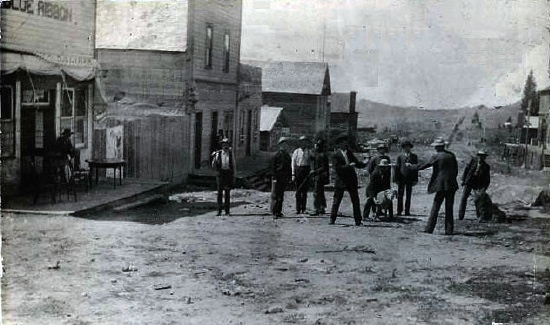
Two Gentlemen about to duke it out in front of the
Blue Ribbon Saloon, Dillon, Wyo., 1904
Slightly south of the Rudefeha Mine on the west side of Sierra Madra was Dillon. The town was formed when
booze was banned in Rudefeha. The town was
named after Malachi W. Dillon who was involved in various mining ventures beginning with
coal in Carbon in the mid 1880's and apparently ending with a gypsite mine in the
Seminoe Mountains about 1915. Dillon may have been an itenerant prospector. He was apparently born in
California in 1864 and was in Carbon County by 1886. In 1892, a Malachi W. Dillon was found guilty of
voluntary manslaughter in Utah.
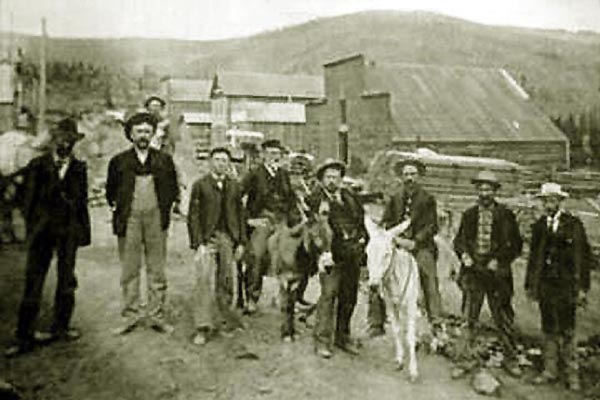
Dillon, Wyo., 1904
Dillon was a companion town
to Copperton which was about 4 1/2 miles down Haggarty Gulch from Dillon.
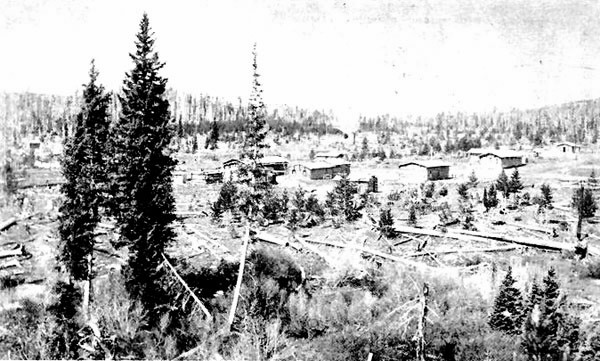
Copperton, Wyo., approx. 1904.
The Copperton Townsite Company was founded in 1900 by former Governor J. E. Osburne, James Douglas, A. McKinnie and J. E. Cosgriff of Rawlins.
The area of Copperton was one which was used for pasturing sheep. The development of the area and
potential opening of mines was not one which was received well by local sheepherders.Sheepherders invaded the town and shot up the
saloons, or as more colorfully expressed by the July 25, 1900, Laramie Daily Boomerang,
"mutton whackers," "smoked up" the town. The little town perservered for several years. In 1903, aluvial placer gold was
discovered adjacent to the townsite. The town was a convenient stopping point for string teams heading up the gulch to Dillon and
Rudafeha. But ultimely a more convient wagon road was built over the divide from
Encampment. The mines promoted by H. O. Granberg were all duds. In Dillon,
the Doublejack lasted a bit longer with items being printed in the Denver News. One item published in
1906 got the attention of the editor of the Phoenix [British Columbia Pioneer, April 7, 1906:
Western editors are sometimes held personally responsible for their comments upon the
doings of the towns in which they live, and they sometimes show that
the pen is not the only weapon they can wield. The Dillon (Wyo.) Doublejack
is a case in point, as shown by the following dispatch to the Denver
News:
"Two Copperton characters, known as Hard Pan Pete and Bedrock Bill,
are recovering from the effects of an effort to clean out the office
of the Dillon Doublejack, a weekly newspaper published here. The men
took exception to a story published by the editor of the Doublelack,
entered the office and announced that it was their intention to wipe the
floor with him. The editor, not at all dismayed, seized a doublejack,
which is kept in the office as the insignia of the paper, and
attacked Hardpan and Bedrock so effectively that both were laid out
in short order and neither was able to leave the office without
assistance. The editor escaped without a scratch."
"Hard Pan Pete" and "Bedrock Bill" was a name occasionally conferred by various
writers to aluvial prospectors in the West. The prospectors are looking for hard pan or
bedrock overlain by "placer ground," an area of alluvial deposts
with a show of yellow. There, one may dig down to a layer beneath which there is either hard pan, an impervious layer of
clay, or bedrock. There pockets of larger "chunky" gold particles might be found.
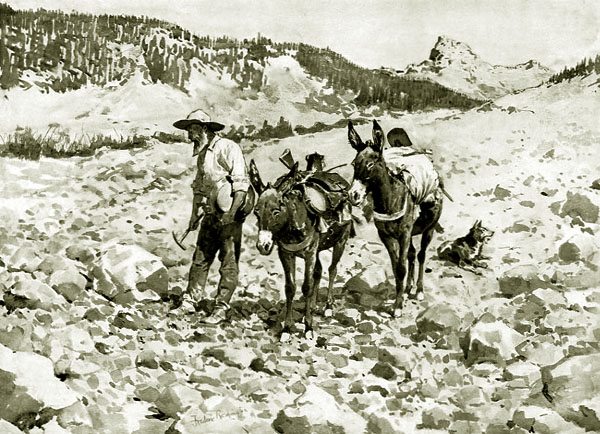
"The Gold Bug" Frederick Remington, 1997. The illustration was used by the
United State Post Office on its 1898 Trans-Mississippi issue enttled the "Western Mining Prospector". .
The Reverend Pete Rosen in his
1896 "Pa-ha-sa-pah, or, the Black Hills of South Dakota," Nixon Jones Printing Co, reference one such
prospector from the Black Hills, found a claim, sold it and moved on to the Big Horns and came back with naught having lost all.
PECULIARITIES OF MINERS.
"Bed-rock Bill" is a good fellow, an honest miner. This is not his
baptismal and patronymic appellation as bestowed on him at an early
age by his godfather and godmother, but a friendly appellation bestowed
on him by his companions in toil, from the fact of his continually
talking of bed-rock, working on bed-rock and receiving all the
remuneration he acquired from bed-rock. For on that, he says:
"In his claim only lies his pay." Bed-rock Bill had fine
prospects; he toiled early and late, and each clean-up increased
in value and gave inspiring hope of the future fortune of "the honest
miner." His girl, too, was "fair and fat, if not forty," and the hopes
of their speedy union inspired Bill to more exertion, till
every nerve was strained to make his claim the richest in the gulch.
But the true course of mining, like true love, does not always run
smoothly. The new diggings were talked of. The big stampede commenced
and poor Bill took the fever, a dangerous epidemic that his susceptible
nature could not withstand, and heedless of the advice of friends,
and the entreaties of his fair one, he sold his claim and made one
among the many that numbered the prospectors.
According to the Reverend Rosen, the prospector's return was described by the
"muse" of the miners::
He's now returned all tattered and torn,
By looking for gold on the Big Horn.
He has no malt,
He has no cat,
He has no coat,
He has no hat,
His trousers patched with an old flour-sack,
With ' for family use' to be seen on the back;
His beard is slaggy, his hair is long,
And this is the burden of his song:
The towns of Copperton and Dillon received notoriety as a result of additional
sydicated columns written by Grant Jones the editor of the Doublejack for newspapers about the country.
Following Jones' graduation from Northwestern in
1897, Jones became a
national writer for the Chicago Times-Herald, covering among other events, the national Republican convention at which
William McKinley was nominated. He was a popular after dinner speaker. His career, however, went
into decline as a result of excessive booze. He first went to Colorado and
then to the Encampment District where he founded the Dillon Doublejack for which every miner in town was a
"special correspondent." [Writer's note: "doublejack drillings" is a method of hand hardrock drilling.
One man holds a steel drill bit while the other grasping a six to eight pound sledge hits the bit. After each blow the
first man turns the
bit. The one holding the bit must have extreme confidence in the one driving the bit. If the second one
misses there is likely to be major injury.] Jones wrote columns about mythical animals, perhaps
similar to "pink elephants," including the one-eyed Screaming Emu and the six-legged Coogly Woo. He died in his cabin
on June 19, 1903, in an incident involving the injection of morphine whilst intoxicated. The cabin was described by Willis George Emerson in his
Treasure of Hidden Valley:
Grant Jones' bachelor home consisted of a single room — a hastily improvised shack,
as he had correctly called it, that had cost no very large sum to build. It was decorated
with many trophies of college life and of the chase. Various college pennants were on the
walls, innumerable pipes, some rusty antiquated firearms, besides a brace of pistols which
Jim Rankin had given to Grant, supposed to be the identical flint-locks carried by Big Nose
George, a desperado of the early days.
Grant's college fraternity, , Phi Delta Theta, Illinois Alpha Chapter,
in its memorial politely referred to
his death as "sudden."
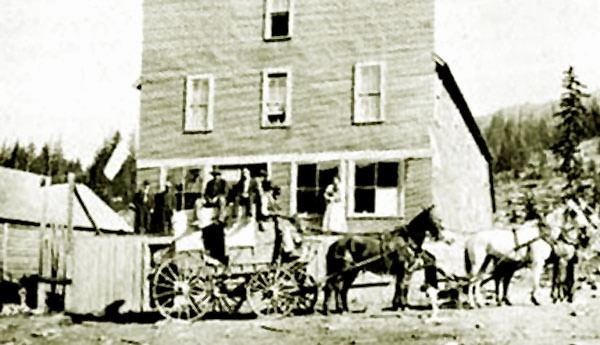
The Dillon Stage
Because of the depth of the snows in the winter, Dillon boasted of a two-story outhouse. In
July, 1909 Episcopal Bishop Nathanial S. Thomas visited Dillon and
Copperton. The road from Encampment to Dillon and Copperton was covered in snow. One driver refused to go through.
A writer for the Wyoming Tribune, July 29, 1909, p 2, was less than impressed with the two towns. In Copperton there was no
room at the inn. In Dillon, the bishop rounded up a congregation of four from the
saloon.
The
two towns were the alleged headquarters for
Stemp Springs Coal & Power Co., formed by Ole Granberg and Henry O. Granberg of Oshkosh, Wisc. Granberg was also involved with
the Copper Queen Consolidated Mining Co, the Anchoria Copper Mining Co.the Hahn's Peak Gold Mining & Milling Co, the Jack Pot Mine, the Royal Flush Mine,
and the Pluto Mining Company. Granberg actually visited Dillon, but he told the
Oshkosh Daily Northwestern, December 1, 1903, p. 10, he did not care to remain there. By 1906, letters to the mining company were being
returned "unclaimed." He did stop off, however, in Cheyenne, to see the hanging of Tom Horn.
Granberg is
now remembered as having allegedly purchased a fake 1804 silver dollar from a Pinkerton Agent for $100.00. If
real it would have been worth a fortune. It was in reality a more common 1800 silver dollar whose date
had been altered. In the rush to the mountains to sell stock, another Oshkosh resident who profession was
formerly shown as a bartender and propriator of a sample room found himself as the president of the
Hahn's Peak Gold Mining and Milling Co. The Pluto Gold & Copper Company did slightly better. It was formed in
1902 and was capitalized at $1,000,000. Although, it actually opened a mine with
five shafts, the deepest of which was 100 feet, and had some 2,000 feet of workings and a 40 hp. steam plant. But the glowing reports given by
Granberg would seemingly indicate, based on the illustration below, that the mine's prospects were
somewhat exaggerated.
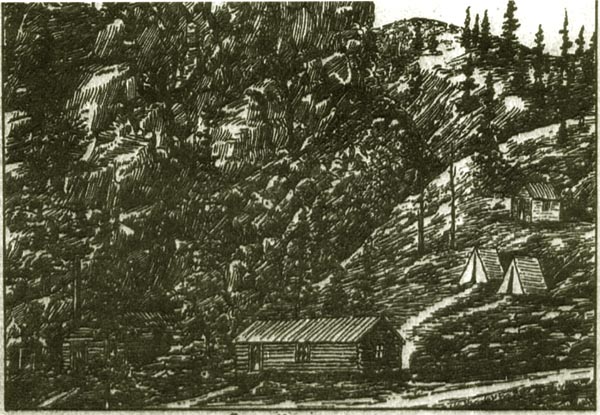
The Pluto Mine
By 1909, representatives of Local
No. 189 of the Western Federation of Mines, wrote the National begging off from paying the $77.00
national assessment because the mine had closed before the assessment could be collected and most of the men had departed town.
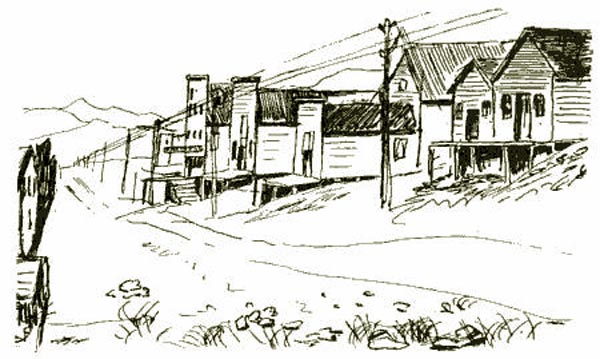
Dillon, Pencil Sketch by Dean Bode, 1909
Other companies attempted to promote themselves by reference to the apparent success of the
Rudefeha. As an example, a prospectus for the Great Lakes Mining and Smelting Co., allegedly located
five miles south of Encampment, boasted of the number of loads of ore being shipped. What
the prospectus failed to advise gullible investors was that the loads were for the Rudefeha Mine and not
its own from which no ore was being mined. Thus, promotional material for such companies compared themselves
to the Rudefeha even though little more had been done than provide glowing assays. As
another example the only developmental work for the Island City Copper Mining Co. was the
digging of a 15 ft. hole. Of a similar nature was the Calamet Mining &
Milling Co. whose development consisted of a 16 foot hole. The company claimed that
its ore assayed out at 70% copper. Most of the companies were gone by 1907.
From the cloudy crystal ball department: in 1907, the State Geologist Henry C. Beeler reported as to the
mines featured on this page:
The two mines of the Penn-Wyoming Copper Company,
the Ferris-Haggarty and the Doane-Rambler, are in active operation.
In the former some' new ore shoots have been opened and the mine bids
fair for a greater production than ever, as it has been put in
first-class physical shape and the ore handled at a less cost per
ton. Diamond drill prospecting has been going on in the lower levels
of this mine this year, exploring the adjacent formations for parallel
ore shoots, but the results have not yet been given to the public.
In the Doane-Rambler mine, work has been confined to reopening the
working levels, putting them in shape for a large production and
connecting the mine with the sixteen-mile overhead tramway, which
transports the ore from the Ferris-Haggarty mine to the Encampment
smelter and the railroad. There is no reason, why an active production
campaign should not be made, and the management of this enterprise is
to be congratulated on what it has accomplished, in the face of what
appeared to be almost insurmountable difficulties, in the way of fires,
scarcity of labor, financial depression and an arbitrary and needless
decline in the price of copper, which occurred just as it had completed
its new works and was prepared to produce at a handsome profit.
This new smelter and railroad have made the future of the Encampment
district a certainty, as there has never been any doubt as to the ores
here, and new work is going on all over the district.
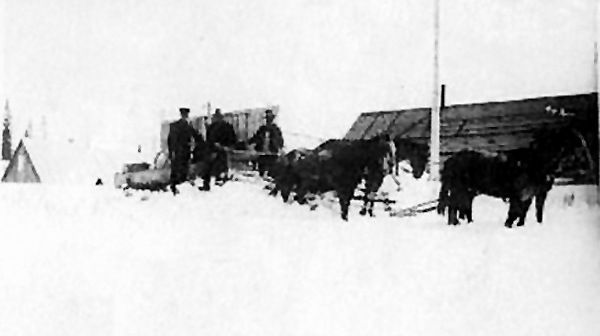
Rambler, approx. 1904
The mines closed the next year. The Penn-Wyoming Company was over extended with the cost
of the infastructure, several fires at the smelter and a reduction in the price
of copper. In order to promote the sale of its stock, the company resorted
to the declaration of dividends when it was making no money. The assets were
sold to the United Smelters, Railway & Copper Company, but to no avail. A receiver
was appointed and the assets foreclosed upon.
When the shafts of the Rudefeha Mine were sealed no provision
was made for drainage and the shafts are now flooded with some seepage poluting nearby
steams.
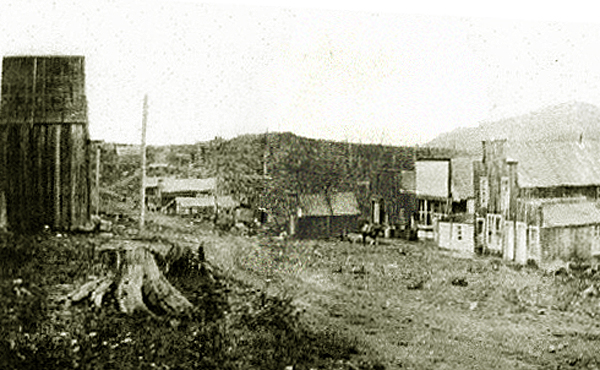
Rambler, Wyo., 1898
Rambler, located in the Grand Encampment Mining
District of southern Carbon County, was established by Rumsey, Deal, Ferris amd Haggarty
as a part
of their copper mining operations. The Rudefeha Mine was the most important in the area. The Rambler was
the second most important in production followed by the Kurtz-Chatterton.

Bird's eye view of Rudefeha Mine, Rambler, Wyoming. Tramway terminal in
tall building at right of photo. The ore was hauled
from Rambler by mule train to the smelter in Encampment.
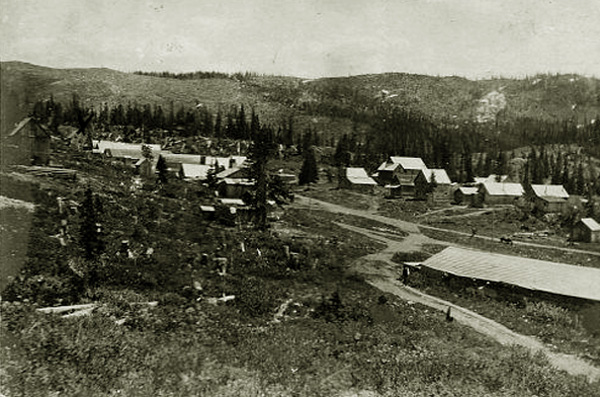
Rambler, Wyoming, 1907.
Two years later, the town, along with Dillon and Copperton, were esentially abandoned. In the
1930's there was one sawmill still being operated at the former site of Copperton. By about 1939, Copperton
was occupied by one abandoned cabin in a partial state of ruin.
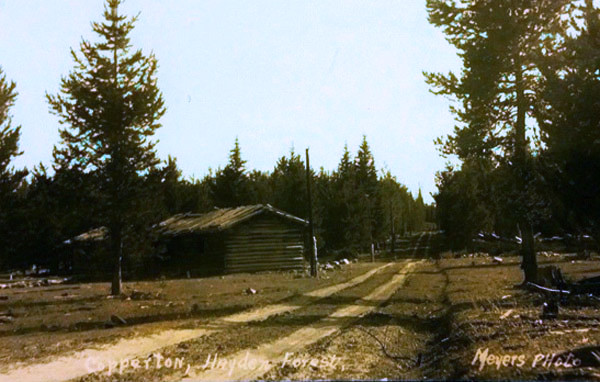
Former site of Copperton, approx 1939.
Dillon in 1941 was described in the WPA Guide to Wyoming as consisting of
roofless cabins, old iron bedsteads, stoves, can, broken wagon parts and innumerable bottles. The
road up the Gulch to Dillon from Copperton where string teams formerly hauled supplies and
returned with ore was marked by ruts which faded to a footpath.
Most of the building in Rambler were in a state of collapse except a few occupied by Sheepherders.
Next page: Battle continued.
|